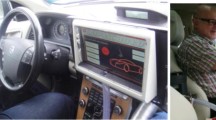Abstract
The design of interfaces for automotive information systems is a critical task. In fact, such design must take into account that user is busy in the primary driving task, and any visual distraction determined by telematics systems can cause serious safety problems. To limit such distraction and enhance safety, in this paper we propose a novel multimodal user interface. The key element of the proposal is a new interaction device, named Handy, conceived to exploit the driver’s tactile channel to minimize the workload of visual channel. Moreover Handy is suitably integrated with the graphical user interface, which is characterized by a reduced number of choices for each state and has been designed in agreement with the self-revealing approach.
Access this chapter
Tax calculation will be finalised at checkout
Purchases are for personal use only
Preview
Unable to display preview. Download preview PDF.
Similar content being viewed by others
References
Marcus, A.: Vehicle User Interfaces: the next revolution, Interactions, 1 (2004)
Gellatly, A.: The use of speech recognition technology in automotive applications, PhD thesis, Virginia Polytechnic Institute and State University (1997)
Redelemeir, D.A.: Associations between Cellular-Telephone Calls and Motor Vehicle Collisions. The New England Journal of Medicine 336 (February 1997)
Cellario, M.: Human-Centered Intelligent Vehicles: Toward Multimodal Interface Integration. IEEE Intelligent Systems (2001)
Shneiderman, B.: Designing the User Interfaces. Addison-Wesley, Reading (1998)
Commission recommendations of 21 December 1999 on safe and efficient in-vehicle information and communication systems: A European statement of principles on HMI (1999)
Burnett, G., Porter, J.: Ubiquitous computing within cars: designing controls for nonvisual use. Int. J. Human-Computer Studies 55, 521–531 (2001)
Smith, E.: Driven to Distraction, New York Times Magazine, New York, December 2 (2002)
Kurtenbach, G.: The design and the evaluation of marking menus, PhD thesis, University of Toronto (1993)
Miller, G.: The magical number seven, plus or minus two: Some limits on our capacity for processing information. Psychological Science 63, 81–97 (1956)
ISO/DIS 2575 Road Vehicles – Symbols for controls, indicators and tell-tales 12/01/95
Rogers, S.P., Campbell, J.L.: Guidelines for automobile hand control locations and actuations based upon driver expectancies and ergonomic principles (TR 947-1). Anacapa Sciences, Inc., Santa Barbara (1991)
Ross, T., Vaughan, G., Burnett, G., May, A.: HARDIE, Design guidelines for route guidance and navigation (1996)
Brewster, S., Wright, P., Edwards, A.: An evaluation of earcons for use in auditory human-computer interfaces. In: Proceedings of InterCHI 1993, Amsterdam (1993)
Brewster, S., Brown, L.: Tactons: Structured Tactile Messages for Non-Visual Information Display. In: Proc. of 5th Australasian User Interface Conference, Dunedin (2004)
Gish, K., Staplin, L.: Human Factors Aspects of Using Head Up Displays in Automobiles: A Review of the Literature, NTSHC interim report (1995)
Strategies for Reducing Driver Distraction from In-Vehicle Telematics Devices: A Discussion Document, Standards Research and Development Branch, Road Safety and Motor Vehicle Regulations Directorate Transport Canada (2003)
Author information
Authors and Affiliations
Editor information
Editors and Affiliations
Rights and permissions
Copyright information
© 2004 Springer-Verlag Berlin Heidelberg
About this paper
Cite this paper
Costagliola, G., Di Martino, S., Ferrucci, F., Oliviero, G., Montemurro, U., Paliotti, A. (2004). Handy: A New Interaction Device for Vehicular Information Systems. In: Brewster, S., Dunlop, M. (eds) Mobile Human-Computer Interaction - MobileHCI 2004. Mobile HCI 2004. Lecture Notes in Computer Science, vol 3160. Springer, Berlin, Heidelberg. https://doi.org/10.1007/978-3-540-28637-0_23
Download citation
DOI: https://doi.org/10.1007/978-3-540-28637-0_23
Publisher Name: Springer, Berlin, Heidelberg
Print ISBN: 978-3-540-23086-1
Online ISBN: 978-3-540-28637-0
eBook Packages: Springer Book Archive



